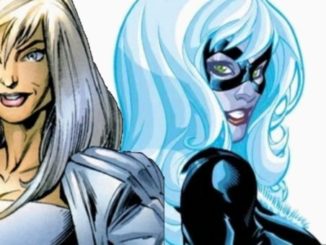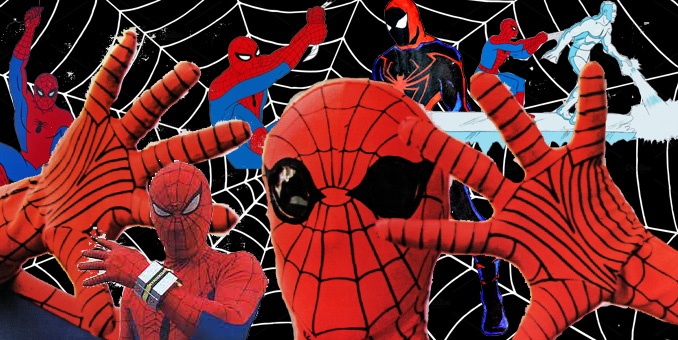 For the next few days, in honor of Spider-Man: No Way Home‘s release, we will be tracing the circuitous path Spider-Man took from the comic book page to screen both small and big. This draws on this site’s HISTORY OF THE COMIC BOOK FILM feature that ran from 2011 to 2016, with new and updated information for your enjoyment.
For the next few days, in honor of Spider-Man: No Way Home‘s release, we will be tracing the circuitous path Spider-Man took from the comic book page to screen both small and big. This draws on this site’s HISTORY OF THE COMIC BOOK FILM feature that ran from 2011 to 2016, with new and updated information for your enjoyment.
The story of Spider-Man’s creation varies depending on how Stan Lee chose to portray it. Sometimes he says he was inspired by a spider crawling up the wall. Sometimes he was inspired by the teenage demographic that was reading Marvel’s output at the time. And sometimes it was his desire to put a new spin on how a teenage character would be portrayed in comics, as they usually were used in humorous stories (for example, Archie Andrews) or as sidekick to a hero (notably Robin) but never as the hero themselves. Whatever the true story is, it was a hard sell for Lee. He had to argue with Marvel’s then-publisher, Martin Goodman, in order to have the story published, and then only published in July 1962’s Amazing Fantasy #15, the last issue of a failed anthology series (which was, essentially, only one step above being relegated to the trash heap). But instead of becoming a throw-away idea, Spider-Man became Marvel’s biggest star.
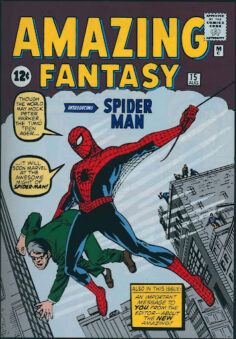 Lee first went to his typical creative partner, Jack Kirby, to work out the concept. Kirby returned with a repurposed idea he and his former partner Joe Simon had for a revamp of the Archie Comics’ superhero the Fly. Kirby’s Spider-Man would be an orphan boy who finds a magic ring that turns him into a web-gun wielding adult superhero (if it being repurposed from the Fly wasn’t enough, that origin skewed maybe a bit too closely to Fawcett’s Captain Marvel). Kirby drew up some sketches to flesh out his ideas for the character, but they weren’t to Lee’s liking. They were too beefy and conventionally heroic. As much as Kirby’s heirs say that Spider-Man is a Jack Kirby creation, the only thing that really survived from his idea is a mechanical web-shooter (albeit now in the form of a wrist-mounted model).
Lee first went to his typical creative partner, Jack Kirby, to work out the concept. Kirby returned with a repurposed idea he and his former partner Joe Simon had for a revamp of the Archie Comics’ superhero the Fly. Kirby’s Spider-Man would be an orphan boy who finds a magic ring that turns him into a web-gun wielding adult superhero (if it being repurposed from the Fly wasn’t enough, that origin skewed maybe a bit too closely to Fawcett’s Captain Marvel). Kirby drew up some sketches to flesh out his ideas for the character, but they weren’t to Lee’s liking. They were too beefy and conventionally heroic. As much as Kirby’s heirs say that Spider-Man is a Jack Kirby creation, the only thing that really survived from his idea is a mechanical web-shooter (albeit now in the form of a wrist-mounted model).
Steve Ditko was next up to the plate, and he hit one out of the park. He drew a spindly, awkward kid for Peter Parker and Spider-Man, a break from the barrel-chested heroes common in comics those days. Ditko’s art matched the put-upon, can’t-catch-a-break characterization that Lee created for the character.

Even though Goodman intended Spider-Man to die a quick and painless death with Amazing Fantasy, fans had other ideas. They responded to Lee and Ditko’s unique take on the superhero, and they wanted more. Well, they got more. Spider-Man soon got his own series, The Amazing Spider-Man, six months later. Two years later, another comic was added (reprint title Marvel Tales) then another (1972’s Marvel Team-Up, which became Web of Spider-Man in 1985), then another (Spectacular Spider-Man in 1977).
If you grew up in the 1960s, 1970s or 1980s, Spider-Man was Marvel Comics. He was on the company’s masthead. He was featured on T-shirts, bedspreads, dolls, Underoos, Halloween costumes and various other forms of ephemera. He was not only by far Marvel’s most recognizable character he was also one of the most recognizable characters in the whole world. However, his journey into the realm of other media was a turbulent one.
 Cartoons based on Spider-Man and the Fantastic Four debuted on the same day, September 9, 1967, as the first Marvel heroes to headline their own cartoons (an anthology series, The Marvel Super Heroes, had a brief run the year before). Spider-Man ran on Saturday mornings from September 9, 1967, to June 14, 1970, the first two seasons on ABC, the last in syndication.
Cartoons based on Spider-Man and the Fantastic Four debuted on the same day, September 9, 1967, as the first Marvel heroes to headline their own cartoons (an anthology series, The Marvel Super Heroes, had a brief run the year before). Spider-Man ran on Saturday mornings from September 9, 1967, to June 14, 1970, the first two seasons on ABC, the last in syndication.
This series start out being done on the cheap, and got even cheaper as the years went on. Spidey’s costume only had webs on his mask, gloves an boots. Certain scenes were used over and over again in future episodes. By the third season, producers were using stock footage from other cartoons to fill the episodes’ run times. This made it a bit cheesy, but if you were a fan of the character, that didn’t matter much. It was great seeing Spidey in motion. The series was most notable for two things–it’s infectious theme song and the fact that animation legend joined the show during its second season.
It would take 11 years before we got another animated Spider-Man, but in between that time we got not one, but two live-action Spider-Man TV shows, Each one separated from the other by an ocean.
 But first, we have to make brief note of another live-action appearance of the character. If you were from my generation, perhaps your first exposure to Spider-Man outside of the comics was in the “Spidey Super Stories” segment of The Electric Company. The skits debuted during the show’s fourth season in 1974, and featured a mute Spider-Man fighting a variety of generic bad guys. The segment inspired Marvel to publish a young reader-friendly comic of the same in the 1970s.
But first, we have to make brief note of another live-action appearance of the character. If you were from my generation, perhaps your first exposure to Spider-Man outside of the comics was in the “Spidey Super Stories” segment of The Electric Company. The skits debuted during the show’s fourth season in 1974, and featured a mute Spider-Man fighting a variety of generic bad guys. The segment inspired Marvel to publish a young reader-friendly comic of the same in the 1970s.
 By the mid-1970s, DC’s Big Three–Superman, Batman and Wonder Woman–all had live-action, prime-time TV shows to their names. It took Marvel until 1977 to get their first offering. That would be The Amazing Spider-Man, which aired on CBS sporadically from September 14, 1977 to July 6, 1979. If the 1967 cartoon was a bit cheesy, then this show was an entire Kraft manufacturing plant. The costume notoriously had its web-shooters and belt on the outside of the costume. Spidey didn’t shoot webs, he shot thick pieces of rope. When he climbed walls, you can see the wires pulling him up (which, to be fair, were pulling him up wall that was several stories off the ground). He didn’t fight Doctor Octopus or Green Goblin, but cheaper-to-produce bad guys such as a New Age guru into mind control and your assortment of mad scientists and gangsters.
By the mid-1970s, DC’s Big Three–Superman, Batman and Wonder Woman–all had live-action, prime-time TV shows to their names. It took Marvel until 1977 to get their first offering. That would be The Amazing Spider-Man, which aired on CBS sporadically from September 14, 1977 to July 6, 1979. If the 1967 cartoon was a bit cheesy, then this show was an entire Kraft manufacturing plant. The costume notoriously had its web-shooters and belt on the outside of the costume. Spidey didn’t shoot webs, he shot thick pieces of rope. When he climbed walls, you can see the wires pulling him up (which, to be fair, were pulling him up wall that was several stories off the ground). He didn’t fight Doctor Octopus or Green Goblin, but cheaper-to-produce bad guys such as a New Age guru into mind control and your assortment of mad scientists and gangsters.
 While The Amazing Spider-Man was airing in the states, another Spider-Man show began airing on Tokyo Channel 12 (TV Tokyo) on May 17, 1978. While you can make the argument that this version was just as cheesy as the one running in the U.S. at the time, the Japanese Spider-Man is more fondly remembered. Maybe because it only bears a passing resemblance to the American version that it turned this cheese into kitsch.
While The Amazing Spider-Man was airing in the states, another Spider-Man show began airing on Tokyo Channel 12 (TV Tokyo) on May 17, 1978. While you can make the argument that this version was just as cheesy as the one running in the U.S. at the time, the Japanese Spider-Man is more fondly remembered. Maybe because it only bears a passing resemblance to the American version that it turned this cheese into kitsch.
The Japanese Spider-Man was Takuya Yamashiro, a motorcyle racer given spider powers via a blood transfusion from an alien from Planet Spider. Yamashiro is charged with protecting the Earth from an invasion by Professor Monster and the Iron Cross Army. The alien also gives Yamashiro his ship, which can transform into a giant robot called Leopardon. The series ran for 41 episodes until March 14, 1979 and served as the inspiration for Super Sentai, which in turn inspired the Power Rangers franchise.
Most of the other entries on this list can be found on home video or streaming, but not these two. The last release of The Amazing Spider-Man happened back in the days of the VHS tapes, and the Japanese Spider-Man last had a Region 2 DVD release in 2009, although it was the focus of a segment of the Disney+ documentary series Marvel 616.
In 1981, Spider-Man would return to the world of animation, this time with two animated series–one that aired in syndication and one that ran on NBC on Saturday morning. I forgot all about the syndicated Spider-Man cartoon, which ran for 26 episodes from September 12, 1981 to March 6, 1982. But that was because the NBC version that started the same day was so iconic.
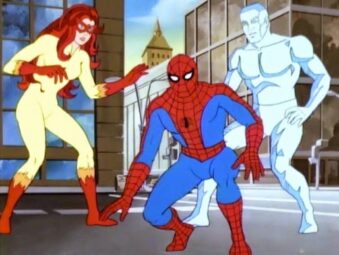 That series was Spider-Man and His Amazing Friends. In case you were not old enough to remember, the series featured Spider-Man, who was roommates with fellow college classmates Bobby Drake and Angelica Jones. They also are the superheroes named Iceman and Firestar respectively Together, they fought crime while trying to keep their secret identities safe from Aunt May and her dog Ms. Lyon, who live in the same house as them.
That series was Spider-Man and His Amazing Friends. In case you were not old enough to remember, the series featured Spider-Man, who was roommates with fellow college classmates Bobby Drake and Angelica Jones. They also are the superheroes named Iceman and Firestar respectively Together, they fought crime while trying to keep their secret identities safe from Aunt May and her dog Ms. Lyon, who live in the same house as them.
Firestar was created directly for the series, but she was later added into the Marvel Universe. Brian Michael Bendis paid homage to the series in the pages of Ultimate Spider-Man. The animated series ran for three season before going into reruns until 1986.
During this time, talk of a Spider-Man film began. Menahem Golan and Yoram Globus had acquired the rights to Spidey. However, there was only one problem: Golan and Globus had no idea who the character was. When they bought the rights to Spider-Man for Cannon Films in 1985, they knew they had a sure-fire concept. Thing is, they thought it was a horror concept about a person who was more spider than man.
Yes, for everyone out there who has issues with either the Sam Raimi or Marc Webb takes on the character, please take a moment to consider that you almost had a film directed by Tobe Hooper where Peter Parker, an ID badge photographer for a science lab, would run afoul of a mad scientist who would have turned him into a human tarantula, eight-furry legs and all. The Internet would have had to have gone public much sooner just so fans could complain about the film on it.
Considering that’s how Spider-Man’s journey to the big screen began, it’s not hard to understand why it took over 17 more years before we got a Spider-Man film.
Fortunately, the film about the Horrific Man-Spider didn’t get much traction. Stan Lee, who by this time had moved out to California to be Marvel’s liaison with the film industry, stepped in and put a stop to that version of the film. Lee convinced Cannon to create a new script to more mirror the original work. That script was written by Ted Newsom and John Brancato and featured a college-aged Peter Parker squaring off against his former mentor, Doctor Otto Octavius a.k.a. Doctor Octopus.
Joseph Zito replaced Hooper as director, brought in Barney Cohen to do a rewrite and was given a budget between $15 to $20 million dollars to work with (for reference, contemporary films RoboCop and Predator had a budget of $13 million and $15 million respectively). Tom Cruise was rumored to be considered for Peter Parker (although this would come after Risky Business and Top Gun, so I think that was mostly wishful thinking), Bob Hoskins for Doctor Octopus, and Lauren Bacall and Katherine Hepburn for Aunt May.

That seems like it would have been a pretty darn great cast! I mean, Katherine Hepburn as Aunt May? A young Tom Cruise as Peter Parker? That film would have made money hand over fist! Unfortunately, Cannon was spending money hand over fist on other projects. Soon, they were unable to afford the $15 million budget. The script was rewritten to make it cheaper, and therefore, poorer in quality. Soon, any hope of getting A-list talent faded away, along with the prospects of the film being made. Cannon shut down the costly project altogether, although still holding onto the rights.
Cannon still had rights in 1989 when they were bought out by French production company Pathé. Menahem Golan used the Cannon buyout to make a break from the company, and in lieu of a golden parachute, he took the rights to Spider-Man with him when he left.
Golan formed 21st Century Production and started the process of raising funds for a Spider-Man film, including selling television rights to Viacom and home video rights to Columbia Pictures. Golan continued developing the film for several years until in 1993 when Carolco, not 21st Century, announced that they had a script in for a new Spider-Man film from none other than James Cameron.
 Titanic was several years away, and Cameron at the time just completed True Lies, but he was still the creative force behind The Terminator, Aliens, The Abyss and Terminator 2: Judgment Day. So this was a big deal in the comic book community. This was the biggest name attached to a comic book project yet, and the fans were excited.
Titanic was several years away, and Cameron at the time just completed True Lies, but he was still the creative force behind The Terminator, Aliens, The Abyss and Terminator 2: Judgment Day. So this was a big deal in the comic book community. This was the biggest name attached to a comic book project yet, and the fans were excited.
I don’t know how excited fans would have been if Cameron’s vision made it to the screen. Cameron did not actually deliver a script, but rather a scriptment (a treatment with a fair amount of dialogue), so what was in that document could have changed before it made it to the big screen. But what was in that scriptment would have caused a bit of a stir in the comic book community.
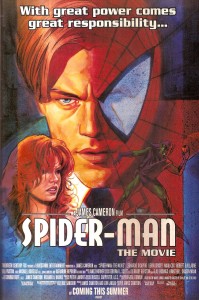
It’s not that Cameron changed a lot of Spider-Man’s mythos, a lot of the film goes step in step with the established Spider-Man mythos. Or that the changes were bad, some did eventually make it into the Raimi films. It’s just that some of the changes were arbitrary. Instead of Flash Thompson, Peter Parker is bullied by Flash McCarthy. The main villain is a man with the power over electricity, but instead of longtime Spidey villain Electro, it is a criminal business man named Carlton Strand. Strand has a lackey that can turn his body into sand, but instead of the lackey being Flint Marko, the Sandman, it is someone named Boyd.
Cameron’s scriptment would have been rated R due to its vulgarity. Peter gains organic web-shooters and discovers he has them during an unseemly nocturnal emission. Peter drops the F-bomb in various forms in the scriptment, is prone to graphic and sadistic violence and has an explicit sex scene with Mary Jane on top of the Brooklyn Bridge. Again, this wasn’t a shooting script, and I’d imagine that a lot of these elements would have been toned down if it made it to the final film, but they are nonetheless a cause for concern.
Although, we will never know how audiences would react. Cameron’s film never made it out of the development stage as the project became bogged down in lawsuits. Golan sued Carolco because he was not credited as a producer on the project as agreed (Cameron was given control over how the credits were done and left Golan’s name off all the promotional materials and press releases). Carolco sued Viacom and Columbia to get the TV and Home Video rights back, and the two companies promptly sued right back. MGM eventually acquired 21st Century’s assets and sued 21st Century, Viacom and Marvel stating there was fraud in the original rights agreements to Spider-Man.

The result was that the project went into limbo for five years. Cameron moved on to make Titanic and never looked back. Carolco, 21st Century and Marvel all went bankrupt. Eventually, the courts decided that the original rights agreement between Cannon and Marvel expired and the rights reverted back to Marvel. MGM disputed this and even though Marvel immediately sold its Spider-Man rights to Columbia, MGM made rumblings that they were going to make a Spider-Man film of their own.
Columbia, who had been eyeing Spider-Man as a tentpole franchise for years, combated this by saying that they were planning on coming out with a James Bond franchise, based on a rights agreement that they made for 1967’s Casino Royale spoof. The Bond franchise was the jewel in MGM’s properties, the one sure money maker that kept them afloat through numerous financial difficulties. To have a competing Bond franchise at Columbia would be devastating. So the two studios came to an agreement: MGM would give up the fight for Spider-Man rights and Columbia would relinquish its 007 rights. Finally, the way was paved for a Spider-Man film.
But before we could get to that, we got two other animated adventures.
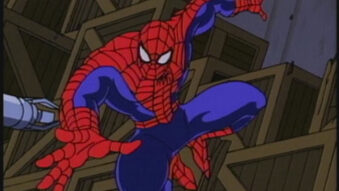 First was the relatively faithful adaptation, Spider-Man, which ran on Fox Kids Network from November 19, 1994, to January 31, 1998 for a total of 65 episodes. One of the notable traits of the series is that a lot of the episodes were adapted from from the comics, including the alien costume, Secret Wars and Clone Saga.
First was the relatively faithful adaptation, Spider-Man, which ran on Fox Kids Network from November 19, 1994, to January 31, 1998 for a total of 65 episodes. One of the notable traits of the series is that a lot of the episodes were adapted from from the comics, including the alien costume, Secret Wars and Clone Saga.
Once that series ran its course, Fox Kids was interested in another Spider-Man cartoon. The only problem was that the Sam Raimi films were ramping up, and Sony didn’t want a cartoon to come in and steal focus away from the films.
 Fox Kids’ answer was Spider-Man Unlimited. The producers of this series really used their imaginations in creating this series, which kept true to the Spider-man mythos, but took it in a whole new direction.
Fox Kids’ answer was Spider-Man Unlimited. The producers of this series really used their imaginations in creating this series, which kept true to the Spider-man mythos, but took it in a whole new direction.
Armed with a new suit designed by Reed Richards, Spider-Man travels to Counter-Earth, a duplicate Earth on the other side of the sun. Spidey travels there to rescue astronaut John Jameson, but eventually falls in with revolutionaries looking to overthrow the High Evolutionary and his Bestial Army.
It was a unique concept, but perhaps too unique for this world. It only lasted a season before being cancelled.
Tomorrow: We cover the Raimi Era and all the glory that it beholds.



